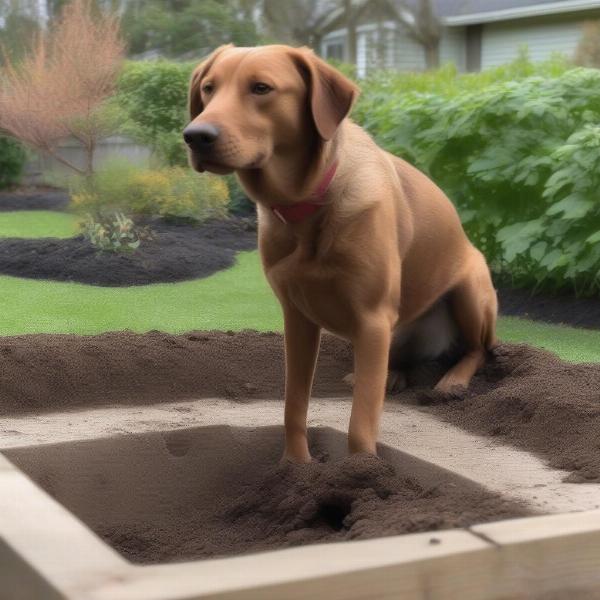Digging is a natural canine behavior, often driven by instinct. Whether it’s a terrier bred to hunt underground or a fluffy companion simply enjoying the feel of cool earth, understanding why your dog digs is the first step to managing, and even redirecting, this innate behavior. This article delves into the reasons behind your dog’s digging habit, provides practical solutions for managing it, and offers tips on creating a digging-friendly zone in your yard.
Why Does My Dog Dig?
Dogs dig for various reasons, some stemming from instinct, others from learned behaviors, and sometimes even due to underlying medical conditions. Understanding the root cause of your furry friend’s digging is key to finding an effective solution. Is your dog bored? A lack of mental and physical stimulation can lead to excessive digging. Are they seeking comfort? Digging can create a cool spot to lie on a hot day or a sheltered den in inclement weather. Perhaps they’re burying a prized possession? This instinctual behavior dates back to their wild ancestors. Or could they be trying to escape? If your dog is digging near fences, they may be seeking an adventure beyond your yard.
 Dog Digging in Garden
Dog Digging in Garden
Managing Your Dog’s Digging
Once you understand the motivation behind the digging, you can implement strategies to manage it. For boredom diggers, increasing physical activity and mental stimulation is crucial. Consider longer walks, engaging puzzle toys, and even training sessions to keep their minds occupied. fun things to do with your dog at home offers some excellent ideas for keeping your dog entertained. If your dog digs for comfort, providing a shaded area or a cozy dog house can deter them from creating their own. For dogs who bury treasures, designate a specific area for them to indulge in this behavior.
Creating a Digging Zone
A digging zone is a designated area where your dog can dig to their heart’s content. This can be a sandbox, a raised garden bed filled with loose soil, or even a specific corner of your yard. Make the digging zone enticing by burying toys or treats for your dog to discover. This will help redirect their digging behavior away from your prized flowerbeds. You can also use positive reinforcement to encourage them to use the designated area. When you see them digging in the right spot, praise them and offer rewards. For persistent diggers, consider a no digging dog spray to deter them from digging in undesired locations. If you’re considering expanding your outdoor space for your dog, a dog run and kennel can offer a dedicated area for play and exploration.
Keeping Your Digger Safe and Stylish
While encouraging appropriate digging, remember to keep your dog safe. Ensure the digging area is free of sharp objects or toxic substances. And for those fashionable diggers, a fancy dog harness can make them look their best while enjoying their outdoor activities. Remember to supervise your dog while they’re digging, especially if they tend to ingest soil or other objects.
Conclusion
Digging is a natural canine instinct. By understanding the reasons behind your dog’s digging, you can effectively manage this behavior and even create a designated digging zone for them to enjoy. With a combination of training, environmental enrichment, and perhaps a few well-placed treats, you and your digging dog can coexist peacefully in a happy and healthy environment.
FAQs
-
Why does my dog dig holes and then lie in them? This behavior often stems from a desire to cool down or create a comfortable den.
-
How do I stop my dog from digging under the fence? Reinforcing the fence, providing distractions, and creating a digging zone can help deter this behavior.
-
Is it bad for my dog to eat dirt? While occasional dirt consumption isn’t usually harmful, excessive ingestion can lead to digestive issues.
-
What can I bury in my dog’s digging zone? Toys, treats, and even dog-safe bones can make the digging zone more appealing.
-
Can I train my dog not to dig at all? While completely eliminating digging might be challenging, redirecting the behavior to a designated area is achievable.
-
My dog is suddenly digging a lot more, should I be worried? A sudden increase in digging could indicate boredom, stress, or even a medical condition. Consult your veterinarian.
-
What kind of soil is best for a dog digging zone? Loose, sandy soil is ideal for a digging zone, as it’s easy to dig in and less likely to compact.
ILM Dog is a leading international website dedicated to providing expert advice on dog care and wellbeing. We offer a comprehensive resource covering breed selection, health, training, nutrition, grooming, and much more. Whether you’re a new dog owner or a seasoned expert, ILM Dog offers valuable insights and practical tips to help you provide the best possible care for your canine companion. For expert guidance and tailored advice, contact us at [email protected] or call +44 20-3965-8624. Visit us at ILM Dog for all your dog care needs.